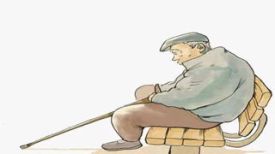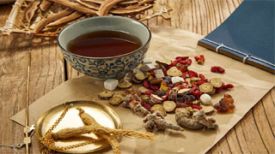
Article excerpt: "Traditional Chinese Medicine Ancient Methods for Infant and Child Health Preservation"
There are many types of cough. Coughing and coughing are different. Cough is called coughing when there is no phlegm but there is sound, and coughing when there is phlegm but there is no sound. It is called coughing when there is both phlegm and sound. Cough can be divided into two types according to its causes: external factors, which are external infections, and internal injuries. There are two types of external infections: wind cold and wind heat, just like a cold. Internal injuries are divided into three types: phlegm heat, phlegm dampness, and yin deficiency.
Why do children like to cough?
A mother asked:
My daughter often coughs, but she doesn't have much phlegm. Sometimes it's not necessarily a cold, but especially when she sleeps at night, she keeps coughing, which is very distressing. I don't know if I caught a cold or for some other reason?
Dr. Peng Xin explained:
Children who are not careful about choking on the wind can cause coughing, and even if they catch a cold, they are prone to coughing. Because the child's internal organs are clear and spiritual, the spleen and lungs are weak, the lung qi is insufficient, and the temperament is insufficient. In this case, the spleen is the source of phlegm and the lungs are the storage vessels for phlegm. When these two organs are injured, moisture can easily accumulate and cause coughing. Therefore, the treatment plan is also corresponding.
Wind cold, cold, cough
The coughing sound caused by wind cold and cold can be heavy, stuffy, itchy, and the phlegm coughed up is clear and thin. Over time, it will turn white. Nasal discharge and clear tears, coupled with a fear of cold and no sweat on the body, are all symptoms of wind cold type cold. If it is severe, it may also be accompanied by fever, body aches, and so on.
Cough caused by wind cold type cold can be treated with Su Ye and Carrot Soup. Su Ye has the function of aromatic purification, and it can also dispel wind and cold.
Ingredients: 5 grams of Su leaves, 5 grams of dried tangerine peel, and 10 grams for older children. Cut half a slice of white radish, add a spoonful of brown sugar, and season to taste. Otherwise, it may not taste good and may not be liked by children. Brown sugar can invigorate the spleen and stomach, and can also induce sweating. Put these ingredients in a pot, add two bowls of water, bring to a boil and simmer over low heat for another 10 minutes. Take them while they are still hot, half a bowl each time.
The traditional Chinese patent medicines and simple preparations for cold and cough is Xingsu cough syrup.
Wind heat, cold, cough
Coughing caused by wind heat and cold is not particularly refreshing, with no phlegm produced, or dry throat and a preference for drinking water. If there is phlegm, it is particularly sticky, yellowish, and more turbid. There is a burning sensation, there may be a smell in the mouth, and the runny nose is also the kind of turbid mucus, not clear mucus. Accompanied by headache, slight sweating, and fever, these symptoms belong to wind heat cold.
The treatment for cough caused by wind heat and cold is Sang Xing Li Tang:
Ingredients: Mulberry leaves, 10 grams or 5 grams are fine, almonds, 10 grams or 5 grams. Almonds can dissolve phlegm, relieve cough, promote lung function, and invigorate qi. One pear, slice it and add some rock sugar to adjust the taste. Rock sugar moistens the lungs and clears heat. Put these raw materials together and boil them in two bowls of water for 20 minutes.
The traditional Chinese patent medicines and simple preparations that can be taken for wind heat cold is Jizhi syrup, which is very symptomatic.
The above two types are external cough, and the following three types are internal cough. External cough is mostly caused by external wind heat and wind cold, while internal injury type cough is manifested as coughing on a regular basis, which can worsen when external pathogens interfere or the cough caused by external factors does not heal for a long time, and is closely related to physical constitution. There are mainly three types: phlegm heat type, phlegm dampness type, and yin deficiency type.
Phlegm heat type cough
Phlegm heat type cough has a lot of phlegm, yellow phlegm, viscous, and not easy to cough out. Dry mouth and tongue, wanting to drink cold water, with phlegm in the throat and the sound of phlegm in the throat; Fever, thirst, restlessness, less urine, yellow color, and dry stool are all manifestations of heat and symptoms of phlegm heat type.
Dietary therapy: Chuan Bei fresh pear loquat soup, boil soup with Chuan Bei and fresh pear and drink. You can also add loquat leaves, which have the effects of clearing the lungs, resolving phlegm, and stopping cough. 5 grams of loquat leaves, 5 grams of Sichuan scallops, one pear, just slice it. Put these ingredients in a pot, add two bowls of water, bring to a boil, simmer over low heat for another 20 minutes, take warm, half a bowl each time.
The traditional Chinese medicine used for phlegm heat cough is Chuanbei loquat paste.
Phlegm dampness cough
The sound of phlegm dampness coughing is very heavy and turbid, as if there is a feeling of a lot of phlegm obstructing the lungs. There is a lot of phlegm discharged, and the color is white and thin. The sound of phlegm in the throat is strong, and when breathing or speaking, the sound of phlegm can be heard. You can feel that there is a lot of phlegm in the throat, which is moist. Another issue is chest tightness and a lack of appetite. Feeling weak and lethargic, with the body prone to fatigue and laziness, is actually a manifestation of poor spleen and stomach function in the middle burner.
The dampness in the middle burner spleen and stomach is relatively high. People with this condition are prone to laziness, drowsiness, lack of appetite, tightness in the chest, and sometimes bloating. When the tongue coating is stretched out, it appears white and greasy, and the stool may be sticky. Some children's stool may not be refreshing, as if it is stuck to the toilet bowl and cannot be flushed down. This is a wet constitution. Children with a wet constitution may cough, which can easily lead to phlegm and dampness.
Dietary therapy method: Use tangerine peel and radish to boil soup and drink. You can add more tangerine peel, 10 grams, and half a radish, slice it. Then boil two bowls of water, bring to a boil for 20 minutes, take warm clothing, half a bowl each time.
The traditional Chinese patent medicines and simple preparations for phlegm dampness cough is Pinellia Dew. Pinellia ternata itself can reduce phlegm, as well as lower qi, cough, and phlegm.
Yin deficiency cough
Coughing more severely at night, less likely to produce phlegm, dry mouth and tongue, and a dry throat. The voice may become hoarse, especially in the afternoon when there may be hot flashes. After noon, at 2 or 3 o'clock in the afternoon, the palms and soles of the feet may heat up or sweat profusely, which are all manifestations of yin deficiency.
Dietary therapy method: Use lilies, almonds, and fresh pears to boil soup and drink. Take 10 grams of lilies and 5 grams of almonds. Pear is put in one, sliced. Then add some rock sugar and adjust the taste. Boil two bowls of water for 20 minutes, take warm clothing, half a bowl each time.
Disclaimer: This article is a sharing of health knowledge. The drugs, prescriptions, acupuncture and moxibustion and other treatment and health preserving methods mentioned in this article should be applied under the guidance of professional doctors, and should not be applied by yourself. We are not responsible for any issues arising from improper use.


